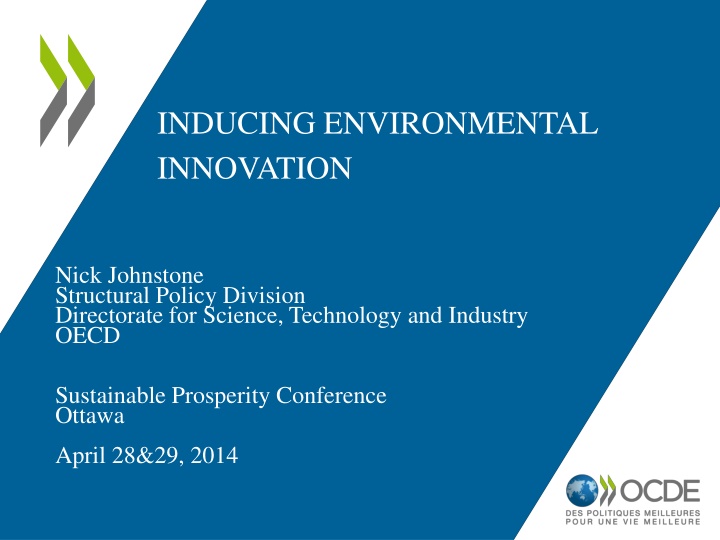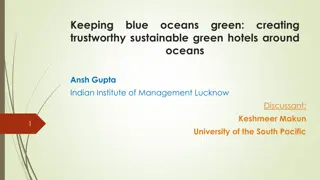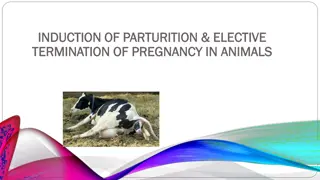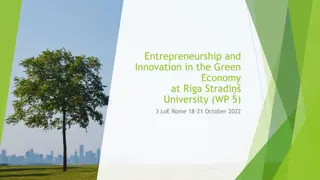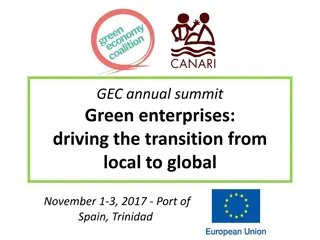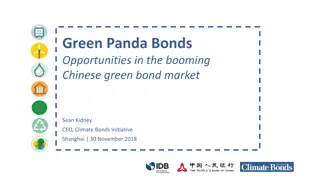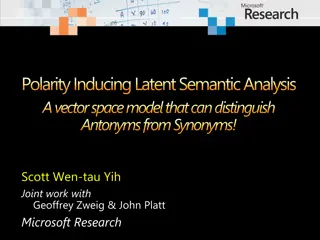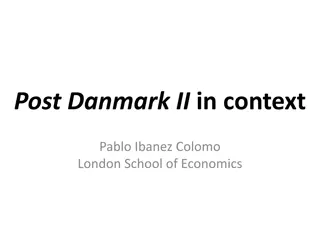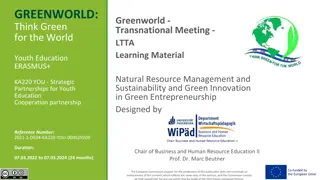Inducing Environmental Innovation: Strategies for Green Growth
This content explores the role of environmental policies in fostering innovation towards sustainable practices. It discusses the impact of policies on patented environmental inventions, principles of policy design, and the importance of flexibility in promoting technological advancements for a greener future. The data presented highlights trends in environment-related patents and the effectiveness of policy stringency and flexibility in encouraging inventive activities in environmental technologies.
Download Presentation

Please find below an Image/Link to download the presentation.
The content on the website is provided AS IS for your information and personal use only. It may not be sold, licensed, or shared on other websites without obtaining consent from the author.If you encounter any issues during the download, it is possible that the publisher has removed the file from their server.
You are allowed to download the files provided on this website for personal or commercial use, subject to the condition that they are used lawfully. All files are the property of their respective owners.
The content on the website is provided AS IS for your information and personal use only. It may not be sold, licensed, or shared on other websites without obtaining consent from the author.
E N D
Presentation Transcript
INDUCING ENVIRONMENTAL INNOVATION Nick Johnstone Structural Policy Division Directorate for Science, Technology and Industry OECD Sustainable Prosperity Conference Ottawa April 28&29, 2014
Environment-Related Patents in OECD Countries (Number of patent applications - claimed priorities, worldwide) 1400 160000 140000 1200 120000 1000 Air pollution abatement (from stationary sources) 100000 800 Water pollution abatement 80000 600 Waste management 60000 Total (right-axis) 400 40000 200 20000 0 0 Source: OECD, Invention and Transfer of Environmental Technologies (2011) www.oecd.org/environment/innovation
CC Mitigation and Adaptation Technologies (Number of patent applications - claimed priorities, worldwide) Source:Ha i , I. et al. (2010), Climate Policy and Technological Innovation and Transfer: An Overview of Trends and Recent Empirical Results , OECD Environment Working Papers, No. 30 http://dx.doi.org/10.1787/5km33bnggcd0-en
Principles of environmental policy design in order to encourage 'green' innovation Stringency/Ambition how ambitious is the policy objective relative to BAU Predictability/Credibility how certain and credible is the signal given by the policy Flexibility how much space is provided to identify new technologies and methods Incidence how closely does the measure target the environmental bad or good Depth does the measure provide incentives over the range of all possible outcomes Source: http://www.oecd-ilibrary.org/environment/environmental-policy-design-characteristics-and-technological- innovation_5kmjstwtqwhd-en 4
The Role of Policy Flexibility: The Effect on Patented Environmental Inventions 1.8 1.6 1.4 1.2 1 Stringency Alone 0.8 Stringency & Flexibility 0.6 0.4 0.2 0 Model 1 (No Year FE) Model 2 (Year FE) Note: Figure shows the estimated coefficients from negative binomial models of different characteristics of environmental policy framework (policy stringency, policy flexibility) in encouraging inventive activity in environmental technologies. Measured as the number of patent applications (claimed priorities) deposited during 1975-2006. Source: OECD (2011) Invention and Transfer of Environmental Technologies www.oecd.org/environment/innovation 5
The Role of Policy Predictability: Effect of Volatility in Public R&D on Inventive Activity 0.50 0.40 0.30 0.20 0.10 Model 1 (No FE) Model 2 (FE) 0.00 R&D Volatility R&D Level -0.10 -0.20 -0.30 -0.40 Note: Figure shows the estimated coefficients from negative binomial models. Figure shows the estimated response to a 1% increase in the level and volatility of public R&D in encouraging inventive activity in environmental technologies, measured as the number of patent applications (claimed priorities) deposited during 1975-2007 in a cross-section of OECD countries. Source: Kalamova, Johnstone and Hascic (2012) in V. Constantini and M. Mazzanti (eds.) The Dynamics of Environmental and Economic Systems (Springer, 2012). 6
The Role of Policy Ambition: Effect of FITs on Cross-border Investment in Renewable Energy Note: The table presents the coefficients of logistic regressions estimated at the deal level. Source: Criscuolo, Johnstone et al. Renewable energy policies and cross-border investment: Evidence From M&A in solar and wind energy OECD STI Working paper (forthcoming) 7
A comparison of environmental taxes and technology-based standards: A caricature Taxes can be ambitious (often depending upon recycling) direct incidence depending upon administrative costs of targeting flexible predictable and credible (depending upon ambition) deep incentives Technology-based standards can be ambitious (but often discriminatory for entrants) indirect incidence generally inflexible predictable and credible (at least in short-run) depth only to standard Source: http://www.oecd-ilibrary.org/environment/environmental-policy-design-characteristics-and-technological- innovation_5kmjstwtqwhd-en 8
Prices spur innovation The Effect of an Energy Tax on High-Value Patent Counts in Combustion Efficiency and Renewable Energy Source: OECD Energy and Climate Policy and Innovation (2012). Based on estimation of sample of OECD economies over period 1978-2008. Results indicate that if oil price is approximately equal to prices reached in 2008 oil shock => switch from fossil fuel combustion efficiency innovation to renewable energy innovation. See also ENV WKP 45
But A Necessary but not Necessarily Sufficient Condition Difficulty of targeting environmental bad directly and excessive administrative costs i.e. environmental policy and transaction costs Secondary non-environmental market failures i.e. information failures, split incentives, network externalities Credibility of policy-induced price signals over the longer term may not be sufficient for risky investments Inertia in the market which can favour incumbent firms and technologies deadweight of past may correlate with environment-intensity
The Need for a Mix of Policies: Sequencing and Complementarity in AFV Technologies 10 Fuel prices 9 Standards 8 7 6 Fuel prices 5 4 Public R&D Public R&D Standards 3 2 1 0 Electric Hybrid Note: For ease of interpretation elasticities have been normalised such that effect of R&D=1. Unfilled bars indicate no statistical significance at 5% level. Source: OECD (2011) Invention and Transfer of Environmental Technologies.
Policy Impacts and Distance from Market To induce a 1% increase in electric vehicle innovations, the alternatives are: Increase R&D by 14% (i.e. $26 mln instead of $23 mln per year per country, on average) Increase fuel price by 63% (i.e. $1.30 instead of $0.80, on avg) To induce a 1% increase in hybrid vehicle innovations, the alternatives are: Increase R&D by 53% (i.e. $35 mln instead of $23 mln per year per country, on average) Increase fuel price by 5% (i.e. $0.84 instead of $0.80, on avg)
Directing Change Without Picking Winners Since technology-neutral pricing of externality is not sufficient = > necessity to be prescriptive (at least to some extent) => main challenge for policy makers Some general principles: Support a portfolio of technologies to diversify risk of getting it wrong Benefits of chosen portfolio should be robust with respect to information uncertainty (i.e. ancillary benefits) Identify general purpose environmental technologies which complement a variety of emission-reducing strategies
Looking Ahead Backstop/Breakthrough Technologies A backstop technology is defined as a new technology producing a close substitute to an exhaustible resource by using relatively abundant production inputs and rendering the reserves of the exhaustible resource obsolete when the average cost of production of the close substitute falls below the spot price of the exhaustible resource. Source: Dasgupta and Heal (1978) 15
Why Does it Matter? Note: Assumptions concerning backstop technologies based on expenditures on technologies which are under research but not yet viable (e.g. advanced biofuels, nuclear and fuel cells) Source: OECD Economics of Climate Change Mitigation. Based on research undertaken by V. Bosetti et al. (2010) in http://www.feem.it/userfiles/attach/2010471754234NDL2010-042.pdf 16
Where Are they Going? 1400 1200 1000 800 NULEAR FUSION CCS 600 400 200 0 1981 1984 1985 1987 1988 1982 1983 1986 1989 2001 1991 2003 2000 2002 2004 2006 2007 2008 2009 1990 1992 1996 1998 1999 2005 1994 1995 1997 1993 Note: All Claimed Priorities and Singulars. Extraction from PATSTAT May 2013. 17
How to Identify? Ideally need to identify trends in costs of green technology and relative to brown substitute. While imperfect - within patent data can draw upon citation, family, class data. Emerging: An emerging technology is defined as one in which prevailing classification system is initially inadequate to identify invention - triangulate through use of co-classes until new class is created. Radical: A radical patent is a patent that cites previous patents belonging to technological classes other than the one(s) the patent itself belongs to. This suggests that the considered invention builds upon a different paradigm from the one it is applied to. Breakthrough: The notion of breakthrough patents captures the extent to which inventions serve as basis for future technological developments. Breakthrough inventions are defined as the top 1% cited patents in a particular year and technology field. General: The concept of generality reflects the importance of patents for later technological developments, and the number of fields i.e. the range of industries .Based on the number and distribution of forward citations and the technological classes these citations belong to. Sources: DSTI/EAS/IND/WPIA(2012)1 and DSTI/EAS/IND/WPIA(2012)6 18
